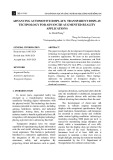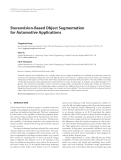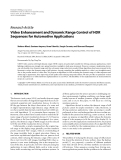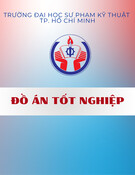
ADVANCING AUTOMOTIVE DISPLAYS: TRANSPARENT DISPLAY
TECHNOLOGY FOR ADVANCED AUGMENTED REALITY
APPLICATIONS
Le Minh Phung
1*
1
Dong Nai Technology University
*Corresponding author: Le Minh Phung, leminhphung@dntu.edu.vn
1. INTRODUCTION
In recent years, augmented reality has
emerged as a transformative technology,
seamlessly blending digital information with
the physical world. This technology has shown
immense potential in various sectors, including
gaming, healthcare, military, and industrial
applications. Among these, the automotive
industry stands to benefit significantly from AR
integration, with transparent display technology
playing a pivotal role in advancing this field.
Transparent displays have the unique
capability of superimposing digital information
onto the real world, allowing for an enriched
visual experience. This feature is particularly
beneficial in automotive applications, where
the integration of AR can enhance driver
awareness, safety, and navigation. By
projecting critical information such as speed,
navigation directions, and hazard alerts directly
onto the windshield or dashboard, transparent
displays provide drivers with real-time data
without diverting their attention from the road.
The development of direct-view AR
systems in vehicles requires transparent
displays with exceptional specifications. High
panel resolution, transmittance, and luminance
are essential to ensure clarity and visibility
under various lighting conditions. Achieving a
resolution exceeding 5000 pixels per inch is
crucial for maintaining image sharpness and
detail, while a transmittance of over 60%
ensures that the display does not obstruct the
driver's view of the road. Furthermore, a
luminance level of at least 1600 nits is
necessary to maintain a clear view even in
bright daylight, meeting the minimum standard
recommended by the U.S. Department of
Transportation for ambient contrast ratio.
GENERAL INFORMATION
ABSTRACT
Received date: 10/03/2024
This paper investigates the development of transparent display
technology for Augmented Reality (AR) systems, particularly
in automotive applications. We focus on key specifications
such as panel resolution, transmittance, luminance, and Field
of View (FOV). Our experiments demonstrate that a resolution
exceeding 5000 Pixels Per Inch (PPI), a transmittance over
60%, and a luminance of 1700 nits are achievable, ensuring
clear and visible AR content in various lighting conditions.
Additionally, a compound eye design expands the FOV to ±70
degrees, enhancing the user experience. These findings
underscore the potential of transparent displays to
revolutionize automotive interfaces, improving safety and
situational awareness.
Revised date: 08/05/2024
Accepted date: 10/07/2024
KEYWORD
Augmented Reality;
Automotive Applications;
Transparent Displays.
01-2025
26
























